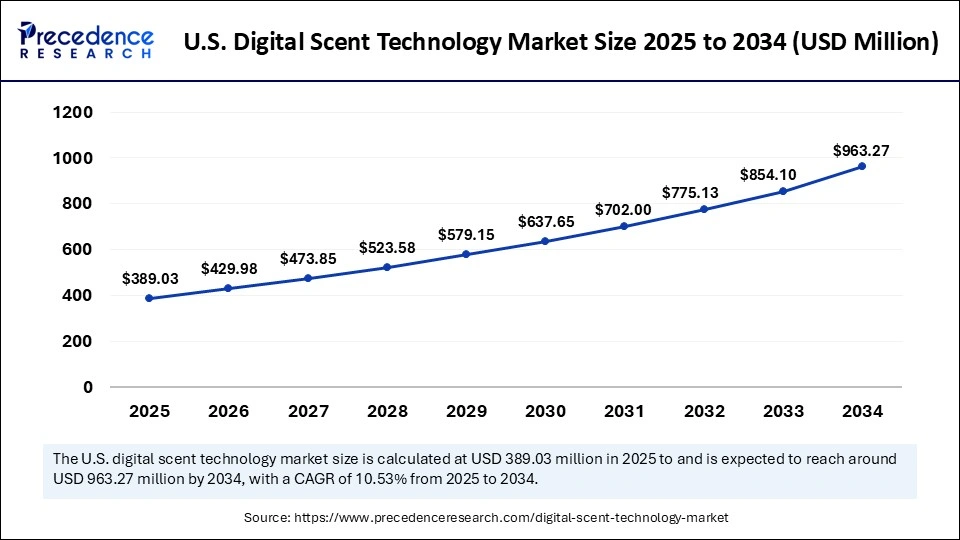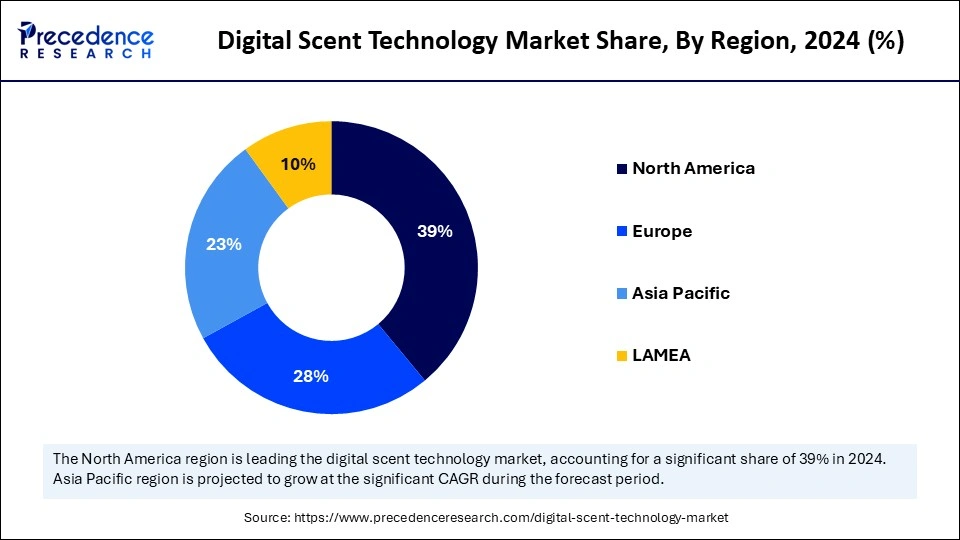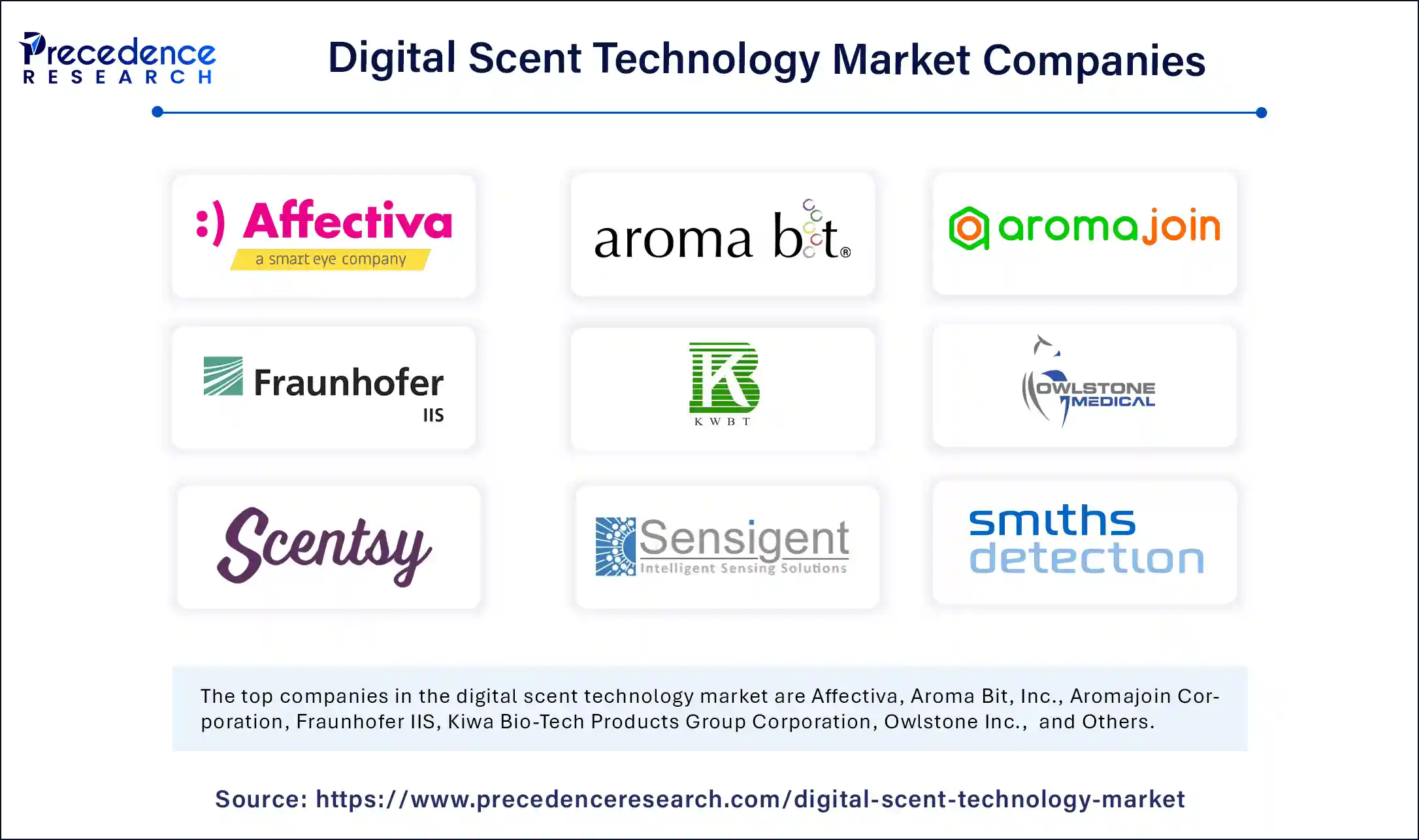List of Contents
What is Digital Scent Technology Market Size?
The global digital scent technology market size is calculated at USD 1.33 billion in 2025 and is predicted to increase from USD 1.47 billion in 2026 to approximately USD 3.23 billion by 2034, expanding at a CAGR of 10.30% from 2025 to 2034. The market is witnessing rapid growth due to the rising demand for effective solutions for improving environmental monitoring and quality control processes.

Market Highlights
- In terms of revenue, the digital scent technology market is valued at $1.33 billion in 2025.
- It is projected to reach $3.23 billion by 2034.
- The market is expected to grow at a CAGR of 10.30% from 2025 to 2034.
- North America held the major market share of 39% in 2024.
- Asia Pacific is expected to grow at the fastest CAGR of 12.5% during the forecast period.
- By hardware, the e-noses segment captured the largest market share of 61% in 2024.
- By hardware, the scent synthesizers segment is projected to grow at a significant rate in the upcoming period.
- By application, the medical diagnostic products segment held the highest share of the market in 2024.
- By application, the smartphone segment is anticipated to grow at the fastest rate during the forecast period.
- By end-use, the medical segment held a dominant share of the market in 2024.
- By end-use, the environmental monitoring segment is projected to expand at the highest CAGR between 2025 and 2034.
Market Overview
Digital scent technology refers to the field that deals with the transmission and reproduction of scents through digital means, permitting users to experience and interact with smells in virtual environments or through digital devices. It involves the use of hardware and software to develop, manage, and emit scents. The digital scent technology market is experiencing rapid growth due to growing demand for immersive experiences, advancements in virtual reality and augmented reality, and the rising application of digital scent technology in various sectors like food & beverage, entertainment, and healthcare. It has the ability to enhance user experiences and improve quality control in various industries.
Impact of Artificial Intelligence on the Digital Scent Technology Market
Artificial intelligence (AI) is transforming the market for digital scent technology by improving scent detection, analysis, and production. It allows more precise odor detection, personalized scent profiles, and the production of new fragrance molecules. AI algorithms can analyze scent signatures to identify specific odors and distinguish them according to a database of known scents. Moreover, AI-powered electronic noses (e-noses) can detect and analyze scents in real-time, expanding the area of applications, including early disease detection through breath analysis. Additionally, AI can learn user preferences and tailor scent delivery based on individual requirements. AI-driven automation can streamline scent production, reducing costs and improving efficiency.
- In October 2024, Scentian Bio developed an AI-enabled scent detection system that can assess the quality, freshness, and authenticity of ingredients in the food and beverage industry. The system helps producers maintain consistent product standards and quality along the production line.
Digital Scent Technology Market Growth Factors
- Diagnostics and Quality Assurance: The adoption of E-noses and their ability to detect changes in air composition and recognize potential gas leaks is valuable in quality control, disease diagnosis, and environmental monitoring.
- Customization and Personalization: The increasing demand for customized scent experiences is leading to the development of scent-mixing capabilities and personalized scent profiles, improving user satisfaction, and various insights into user preferences, emotions, and behaviors are offering valuable market intelligence for businesses.
- Enhanced demand for Immersive Experiences: The demand for more realistic and engaging experiences in entertainment, gaming, and virtual reality by integrated into various platforms to create more immersive and sensory-rich experiences, spurring the adoption of digital scent technology.
- Wide Range of Applications: Digital scent technology finds applications across various sectors, including healthcare for medical diagnosis, military & defense, food & beverage for quality control, and waste management.
Market Scope
| Report Coverage | Details |
| Market Size by 2025 | USD 1.33 Billion |
| Market Size in 2026 | USD 1.47 Billion |
| Market Size in 2034 | USD 3.23 Billion |
| Market Growth Rate from 2025 to 2034 | CAGR of 10.30% |
| Dominating Region | North America |
| Fastest Growing Region | Asia Pacific |
| Base Year | 2024 |
| Forecast Period | 2025 to 2034 |
| Segments Covered | Hardware, Application, End-Use, and Region |
| Regions Covered | North America, Europe, Asia-Pacific, Latin America, and Middle East & Africa |
Market Dynamics
Drivers
Rising Demand for Enhanced User Experiences
The primary driver of the digital scent technology market is the rising demand for enhanced user experiences. Digital scent technology can elevate user experience by enhancing immersive environments in virtual reality, augmented reality, and entertainment. Integrating scent into these experiences boosts realism and engagement. Thus, scent can be used to evoke emotions, trigger memories, and generate unique atmospheres in games and movies, as well as in retail environments to create welcoming atmospheres and influence purchasing decisions.
Restraint
Limited Adoption and Lack of Awareness
Limited adoption and lack of awareness among consumers and businesses are restraining the growth of the digital scent technology market. Digital scent technology is relatively new and not widely integrated into everyday life or business practices, which results in lower adoption rates. Moreover, the higher cost of this technology creates barriers for small and medium-sized businesses and consumers with low incomes.
Opportunity
Technological Advancements
Technological advancements create immense opportunities in the digital scent technology market. Technologies like virtual reality (VR), augmented reality (AR), and AI can improve scent delivery and control. Integrating digital scent technology into smart homes, personal devices, and everyday products such as perfumes or food packaging leads to personalized scent experiences and enhances user engagement. AI technologies also help develop custom scent profiles, enhance scent applications in areas like VR and gaming, and improve healthcare diagnostics and therapies. Moreover, ongoing research and development in sensor technology and scent emission systems, such as electronic noses for low-power consumption and low-cost IoT-enabled devices, drive innovation and market growth.
Hardware Insights
The e-noses segment captured the largest share of the digital scent technology market in 2024. This is mainly due to their rapid adoption and broader application in diverse sectors such as food & beverage, healthcare, and security. The segment's dominance is further attributed to the versatility of e-noses in quality control, early disease detection, and safety improvements. E-noses not only offer a cost-effective and effective alternative to traditional analytical methods but also provide real-time analysis and in situ monitoring. Technological advances, particularly in sensor technology, have improved the accuracy and reliability of e-noses in detecting and recognizing intricate scent profiles.
- In May 2025, Korean scientists developed a next-generation AI electronic nose that can smell and distinguish scents like a human nose. The device demonstrated 95% accuracy in recognizing nine fragrances commonly used in cosmetics and perfumes. It was also capable of detecting the types of smells and concentrations of each scent.
The scent synthesizers segment is projected to grow at a significant rate in the upcoming period. The growth of the segment is attributed to the rising demand for immersive experiences, particularly in entertainment, virtual reality, and augmented reality, where scent provides a vital aspect. Companies are using scent synthesizers to develop specific ambient scents in retail environments, influencing customer behavior and brand perception. Scent synthesizers enhance customer engagement and satisfaction by enabling the development of more realistic and personalized scent experiences.
Application Insights
The medical diagnostic products segment dominated the market with the highest share in 2024, owing to the increased demand for non-invasive diagnostic methods, increased prevalence of chronic diseases, and a strong emphasis on personalized medicine. Digital scent technology, such as eNoses, is used in medical diagnostics to accurately detect diseases by analyzing VOCs in breath or other bodily fluids. Digital scent-based diagnostic tools are often more cost-effective than traditional methods and are gaining regulatory approvals, boosting their adoption in clinical settings.
- In September 2024, Osmo announced its scent teleportation, demonstrating the potential of digital scent technology to capture and transmit odor signatures for analysis, which could have applications in medical diagnostics by adding crucial dimensions to machine-readable data, and digital fragrances will be able to result in their physical counterparts.
The smartphone segment is anticipated to grow at the fastest rate during the forecast period as consumers are increasingly looking for more engaging and multisensory experiences in mobile devices. Companies are incorporating scent capabilities for various purposes, like sensing air quality, analyzing food freshness, and even monitoring breath for health alerts. This technology provides a vital aspect to user experiences, progressively transforming immersive and interactive experiences by surpassing traditional visual and audio input. Integrating digital scent technology into smartphones enables users to control ambient scents, enhancing the overall smart home experience.
End-Use Insights
The medical segment held a dominant share of the market in 2024 and is likely to continue its growth trajectory during the projection period because of the increasing use of digital scent technology in diagnostics, disease detection, and patient monitoring. Specifically, advancements in eNoses, as well as AI and machine learning, enabled non-invasive breath analysis and biomarker-based scent detection for different diseases. Additionally, this technology is versatile in telemedicine and remote health monitoring, thus expanding the scope of diagnostic capabilities.
The environmental monitoring segment is projected to expand at the highest CAGR in the coming years. The growth of the segment is attributed to the increasing demand for air quality assessment, pollution control, and hazardous gas detection. The segment is driven by compliance reporting for accurate and reliable data provision to the companies and by the miniaturization and portability of digital scent sensors for wider deployment in diverse environments. Stringent environmental regulations, rising awareness of pollution and its bad impact on health, and the increasing awareness of the ability of digital scent technology to offer rapid, accurate, and objective odor detection further contribute to segmental growth.
Regional Insights
U.S. Digital Scent Technology Market Size and Growth 2025 to 2034
The U.S. digital scent technology market size is exhibited at USD 389.03 million in 2025 and is projected to be worth around USD 963.27 million by 2034, growing at a CAGR of 10.53% from 2025 to 2034.

What Made North America the Dominant Region in the Digital Scent Technology Market?
North America dominated the digital scent technology market by holding the largest share in 2024. This is because it is a hub for technological advancements and developments, with major tech companies, universities, and research institutions investing heavily in digital scent technologies. The region is at the forefront of technological innovations, boosting the development of new products such as enhanced e-noses and scent synthesizers. The region also benefits from government's public health initiatives aimed at screening and diagnosis of diseases. There is a strong emphasis on quality control in the food industry and early illness detection, further bolstering the growth of the market.
U.S. Digital Scent Technology Market Analysis
The U.S. plays a major role in the digital scent technology market in North America. The country is home to some of the major market players, such as Sensigent LLC and Scentsy, Inc., which can boost the development of advanced digital scent technology. Stringent regulations regarding environmental protection and increasing concerns about air pollution are likely to boost the demand for digital scent technology, including eNoses, for environmental monitoring.

What Makes Asia Pacific the Fastest-Growing Region in the Digital Scent Technology Market?
Asia Pacific is anticipated to grow at the fastest rate in the market during the forecast period. This is mainly due to the rising adoption of eNoses in food quality control and healthcare, and the rise of scent-enabled applications in entertainment and marketing. A large and expanding consumer base, specifically in developing countries, is boosting the demand for immersive, sensory experiences and innovative technologies. Furthermore, smart city initiatives create opportunities for digital scent technology for environmental monitoring, public safety, and other diverse applications.
India Digital Scent Technology Market Analysis
India is expected to have a stronghold on the digital scent technology market due to its vast middle-class population and increasing disposable income. Indian brands are increasingly using sensory marketing to enhance consumer experiences, which opens up new avenues for digital scent technology. The rising demand for premium and niche fragrances supports market growth.
Why is Europe Considered a Significantly Growing Area?
Europe is considered to be a significantly growing area. The growth of the digital scent technology market in Europe can be attributed to the rising acceptance of digital scent solutions in different sectors, such as healthcare and pharmaceuticals. Moreover, European companies are making headway in improving the sensitivity and accuracy of digital scent devices, such as e-noses and scent synthesizers. Stringent environmental regulations imposed by the EU further create the need for digital scent technology, including eNoses, for environmental monitoring.
Germany Digital Scent Technology Market Analysis
In Germany, the market is being propelled by strong integration into the industrial automation and automotive sectors, where e-nose devices are increasingly used for emissions monitoring, cabin air enhancement, and safety applications. At the same time, miniaturisation, AI-driven scent profiling, and expansion into smart home and wearable health devices are enabling cross-sector adoption and driving the growth of digital olfaction beyond traditional boundaries. The "Made for Germany" Initiative, the Federal Ministry for Digital Transformation and Government Modernization (BMDS), and others support R&D and digital innovation. German companies and research institutions are actively involved in research related to sensory and electronic nose technology.
How Big is the Opportunity for the Digital Scent Technology Market in Latin America?
Latin America presents significant opportunities for market growth due to the increasing use cases in food quality control, agricultural monitoring, and public health applications gaining popularity across Brazil, Mexico, and Argentina. With rising investments in technology-driven infrastructure and relatively low adoption of olfactory sensing solutions, the region emerges as a promising growth frontier for vendors and innovators alike.
Brazil Digital Scent Technology Market Analysis
Brazil is leading the market due to the increasing demand for food safety and agricultural quality control applications, where e-nose systems are used to monitor spoilage, verify origin labels, and protect export standards. At the same time, the country is seeing a rise in the use of AI-enabled olfactory sensors in healthcare and environmental monitoring—creating portable, affordable screening tools and establishing Brazil as a regional hub for digital olfaction innovation.
What Potentiates the Growth of the Market in the Middle East & Africa?
The digital scent technology market in the Middle East & Africa (MEA) is driven by significant investment in next-generation infrastructure, especially in smart cities, defense and security systems, and advanced healthcare diagnostics, which boosts demand for olfactory sensors and scent-based solutions. Additionally, the region's growing consumer desire for immersive experiences in retail, entertainment, and brand marketing, along with government-supported digital transformation and innovation efforts, is creating strong momentum for scent tech adoption.
Saudi Arabia Digital Scent Technology Market Analysis
In Saudi Arabia, the market is growing through the integration of smart olfactory solutions into luxury retail, smart home platforms, and customer experience systems, where ambient scenting and personalized fragrances are increasingly linked to digital commerce and brand engagement. At the same time, expanding use cases in healthcare and environmental monitoring, supported by government digital transformation initiatives and the kingdom's focus on lifestyle innovation, are driving the growth of e-nose and scent synthesis technologies.
Digital Scent Technology Market Companies

- Affectiva
- Aroma Bit, Inc.
- Aromajoin Corporation
- Fraunhofer IIS
- Kiwa Bio-Tech Products Group Corporation
- Owlstone Inc.
- Scentsy, Inc.
- Sensigent LLC
- Smiths Detection Group Ltd.
- The eNose Company
Recent Developments
- In June 2024, Aroma Bit, Inc. announced that it had successfully developed a prototype of e-nose type odor imaging sensor using CMOS semiconductors that are the world's smallest*1, highly integrated and high odor resolution.
- In January 2024, researchers in Taiwan have developed an electronic nose (e-nose) that they say can correctly identify a coffee based on its aroma with up to 98% accuracy.
Segments Covered in the Report
By Hardware
- E-noses
- Scent Synthesizers
- Others
By Application
- Smartphones
- Smelling Screens
- Music and Video Games
- Explosive Detectors
- Quality Control Products
- Medical Diagnostic Products
- Others
By End-Use
- Food & Beverages
- Military & Defence
- Medical
- Marketing
- Environment Monitoring
- Entertainment
- Others
By Region
- North America
- Europe
- Asia Pacific
- Latin America
- Middle East and Africa
For inquiries regarding discounts, bulk purchases, or customization requests, please contact us at sales@precedenceresearch.com
Frequently Asked Questions
Ask For Sample
No cookie-cutter, only authentic analysis – take the 1st step to become a Precedence Research client



